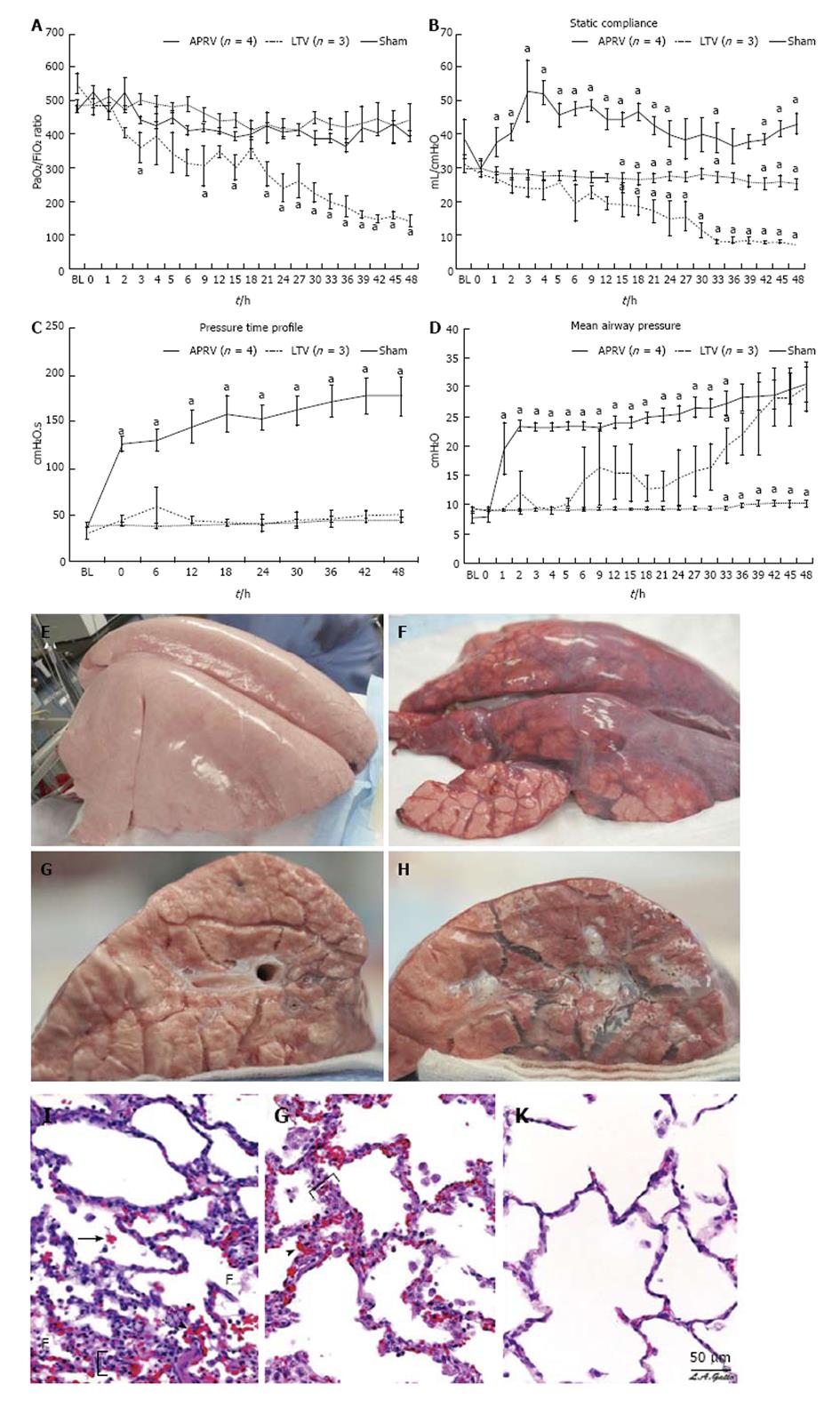Copyright
©The Author(s) 2016.
World J Crit Care Med. Feb 4, 2016; 5(1): 74-82
Published online Feb 4, 2016. doi: 10.5492/wjccm.v5.i1.74
Published online Feb 4, 2016. doi: 10.5492/wjccm.v5.i1.74
Figure 2 Pulmonary, gross and histologic representation between airway pressure release ventilation, LTV and sham animals.
Top: Pulmonary data: A: P/F Ratio: APRV maintains a normal P/F ratio throughout the 48-h study with no significant difference from uninjured sham animals. Low tidal volume ventilation develops ALI (P/F G 300) by 19 h and ARDS (P/F G 250) by 33 h; ventilation strategy does not alter steady progression of increasing hypoxemia (P G 0.001 vs APRV and sham); B: Static compliance (Cstat): the APRV shows significant increase in Cstat after transition from volume- cycled mode to APRV (P G 0.001 vs sham and LTV ventilation). Sham maintained a normal Cstat level throughout the course of the study. In contrast, the LTV ventilation group developed progressive decreases in Cstat to less than 50% of BL; C: Mean airway pressure: sham group maintained normal Pmean throughout 48-h significantly different from both APRV and LTV ventilation (P G 0.001). Pmean was significantly higher in APRV than in both sham and LTV ventilation after transition from conventional ventilation at 1 h. Because of stepwise increases in PEEP per the ARDSnet protocol, the Pmean was identical from 39 to 48 h for LTV ventilation and APRV; D: Pressure-time profile (P/TP): APRV group had significantly higher P/TP than did both other groups as soon as the transition was made from volume-cycled ventilation (P G 0.001 vs sham and LTV ventilation). In the LTV ventilation group, P/TP remained low and did not change over the 48-h course of the study. Sham group animals also had low P/TP, which was not significantly different from the LTV ventilation group throughout the study; Middle: Gross appearance. Representative specimens of gross lungs and cut surface of gross lungs from LTV ventilation (F and H) and APRV (E and G) groups are shown. Bottom I-K: Histological appearance. Photomicrographs of representative lung sections of specimens from each treatment group at 40 × magnification are shown. F: Fibrinous deposit in the air compartment; arrow: Blood in alveolus; arrowhead: Congested alveolar capillary; bracket: Thickened alveolar wall. A: Sham: Animals received 48 h of mechanical ventilation and no injury. Specimen exhibits stigmata of lung injury including fibrinous deposits, blood in alveolus, congested capillaries, and thickened alveolar walls; B: Low tidal volume ventilation: animals received aforementioned ischemic injury along with peritoneal sepsis and LTV ventilation after onset of ALI. Specimen exhibits stigmata of lung injury including fibrinous deposits, blood in alveolus, congested capillaries, leukocyte infiltration, and thickened alveolar walls; C: Airway pressure release ventilation: animals received APRV 1 h following aforementioned ischmic injury and peritoneal sepsis. Specimen shows normal pulmonary architecture, alveoli are well expanded and thin walled, and there are no exudates. Republished with permission from Ref[39]. APRV: Airway pressure release ventilation; PEEP: Positive end-expiratory pressure; ALI: Acute lung injury.
- Citation: Sadowitz B, Jain S, Kollisch-Singule M, Satalin J, Andrews P, Habashi N, Gatto LA, Nieman G. Preemptive mechanical ventilation can block progressive acute lung injury. World J Crit Care Med 2016; 5(1): 74-82
- URL: https://www.wjgnet.com/2220-3141/full/v5/i1/74.htm
- DOI: https://dx.doi.org/10.5492/wjccm.v5.i1.74









